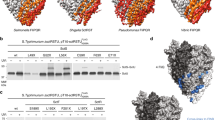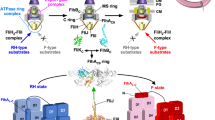Abstract
Assembly of the bacterial flagellum and type III secretion in pathogenic bacteria require cytosolic export chaperones that interact with mobile components to facilitate their secretion. Although their amino acid sequences are not conserved, the structures of several type III secretion chaperones revealed striking similarities between their folds and modes of substrate recognition. Here, we report the first crystallographic structure of a flagellar export chaperone, Aquifex aeolicus FliS. FliS adopts a novel fold that is clearly distinct from those of the type III secretion chaperones, indicating that they do not share a common evolutionary origin. However, the structure of FliS in complex with a fragment of FliC (flagellin) reveals that, like the type III secretion chaperones, flagellar export chaperones bind their target proteins in extended conformation and suggests that this mode of recognition may be widely used in bacteria.
This is a preview of subscription content, access via your institution
Access options
Subscribe to this journal
Receive 12 print issues and online access
$189.00 per year
only $15.75 per issue
Buy this article
- Purchase on Springer Link
- Instant access to full article PDF
Prices may be subject to local taxes which are calculated during checkout





Similar content being viewed by others
References
Aldridge, P. & Hughes, K.T. Regulation of flagellar assembly. Curr. Opin. Microbiol. 5, 160–165 (2002).
Fraser, G.M., Bennett, J.C.Q. & Hughes, C. Substrate-specific binding of hook-associated proteins by FlgN and FliT, putative chaperones for flagellum assembly. Mol. Microbiol. 32, 569–580 (1999).
Auvray, F., Thomas, J., Fraser, G.M. & Hughes, C. Flagellin polymerisation control by a cytosolic export chaperone. J. Mol. Biol. 308, 221–229 (2001).
Bennett, J.C.Q. & Hughes, C. From flagellum assembly to virulence: the extended family of type III export chaperones. Trends. Microbiol. 8, 202–204 (2000).
Page, A.-L. & Parsot, C. Chaperones of the type III secretion pathway: jacks of all trades. Mol. Microbiol. 46, 1–11 (2002).
Bennett, J.C.Q., Thomas, J., Fraser, G.M. & Hughes, C. Substrate complexes and domain organization of the Salmonella flagellar export chaperones FlgN and FliT. Mol. Microbiol. 39, 781–791 (2001).
Macnab, R.M. The bacterial flagellum: reversible rotary propellor and type III export apparatus. J. Bacteriol. 181, 7149–7153 (1999).
Nguyen, L., Paulsen, I.T., Tchieu, J., Hueck, C.J. & Saier, M.H. Jr. Phylogenetic analyses of the constituents of type III protein secretion systems. J. Mol. Microbiol. Biotechnol. 2, 125–144 (2000).
Birtalan, S. & Ghosh, P. Structure of the Yersinia type III secretory system chaperone SycE. Nat. Struct. Biol. 8, 974–978 (2001).
Evdokimov, A.G., Tropea, J.E., Routzahn, K.M. & Waugh, D.S. Three-dimensional structure of the type III secretion chaperone SycE from Yersinia pestis. Acta Crystallogr. D 58, 398–406 (2002).
Trame, C.B. & McKay, D.B. Structure of the Yersinia enterocolitica molecular-chaperone protein SycE. Acta Crystallogr. D 59, 389–392 (2003).
Stebbins, C.E. & Galan, J.E. Maintenance of an unfolded polypeptide by a cognate chaperone in bacterial type III secretion. Nature 414, 77–81 (2001).
Luo, Y. et al. Structural and biochemical characterization of the type III secretion chaperones CesT and SigE. Nat. Struct. Biol. 8, 1031–1036 (2001).
Holm, L. & Sander, C. Protein structure comparison by alignment of distance matrices. J. Mol. Biol. 233, 123–138 (1993).
Ozin, A.J., Claret, L., Auvray, F. & Hughes, C. The FliS chaperone selectively binds the disordered flagellin C-terminal D0 domain central to polymerisation. FEMS Microbiol. Lett. 219, 219–224 (2003).
Birtalan, S., Phillips, R.M. & Ghosh, P. Three-dimensional secretion signals in chaperone-effector complexes of bacterial pathogens. Mol. Cell 9, 971–980 (2002).
Samatey, F.A. et al. Structure of the bacterial flagellar protofilament and implications for a switch for supercoiling. Nature 410, 331–337 (2001).
Kapust, R.B. & Waugh, D.S. Controlled intracellular processing of fusion proteins by TEV protease. Prot. Expr. Purif. 19, 312–318 (2000).
Navaza, J. AmoRe: an automated package for molecular replacement. Acta Crystallogr. D 50, 157–163 (1994).
Jones, T.A., Zou, J.Y., Cowan, S.W. & Kjeldgaard, M. Improved methods for building protein models in electron density maps and the location of errors in these models. Acta Crystallogr. A 47, 110–119 (1991).
Sheldrick, G.M. & Schneider, T.R. SHELXL: high-resolution refinement. Methods Enzymol. 277, 319–343 (1997).
Vagin, A.A. & Dodson, E.J. Refinement of macromolecular structures by the maximum-likelihood method. Acta Crystallogr. D 53, 240–255 (1997).
Acknowledgements
We thank SBL Biophysics Core Resource (US National Cancer Institute at Frederick) for the use of the electrospray mass spectrometer and the Protein Chemistry Laboratory (SAIC-Frederick) for amino acid sequencing. Data were collected at beamlines 17-ID and 17-BM in the facilities of the Industrial Macromolecular Crystallography Association Collaborative Access Team (IMCA-CAT) at the Advanced Photon Source.
Author information
Authors and Affiliations
Corresponding author
Ethics declarations
Competing interests
The authors declare no competing financial interests.
Rights and permissions
About this article
Cite this article
Evdokimov, A., Phan, J., Tropea, J. et al. Similar modes of polypeptide recognition by export chaperones in flagellar biosynthesis and type III secretion. Nat Struct Mol Biol 10, 789–793 (2003). https://doi.org/10.1038/nsb982
Received:
Accepted:
Published:
Issue Date:
DOI: https://doi.org/10.1038/nsb982
This article is cited by
-
Structures of chaperone-substrate complexes docked onto the export gate in a type III secretion system
Nature Communications (2018)
-
Crystal structure of FlgL and its implications for flagellar assembly
Scientific Reports (2018)
-
FliS/flagellin/FliW heterotrimer couples type III secretion and flagellin homeostasis
Scientific Reports (2018)
-
Structural flexibility of the periplasmic protein, FlgA, regulates flagellar P-ring assembly in Salmonella enterica
Scientific Reports (2016)
-
Structural Insights on Two Hypothetical Secretion Chaperones from Xanthomonas axonopodis pv. citri
The Protein Journal (2011)



